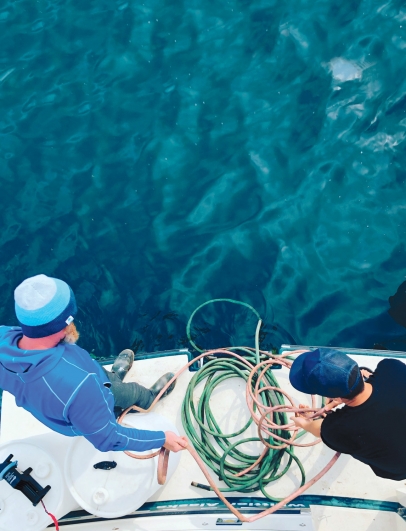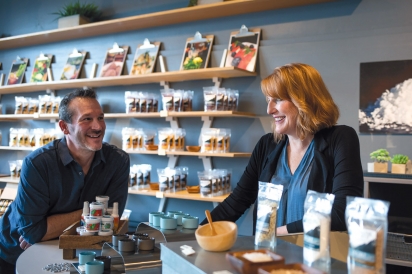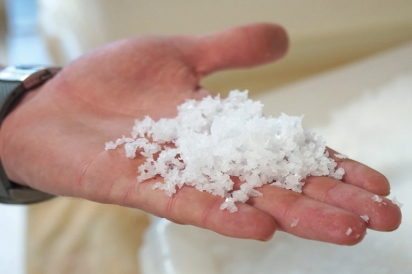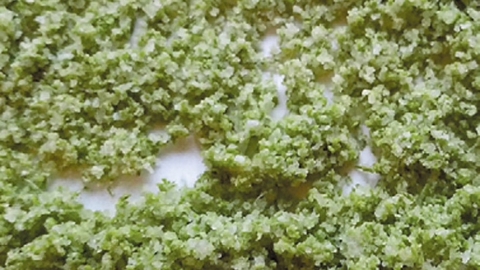Alaska's Flavor Harversters
Local sea salt crystallizes a market
On a rare sunny day in 2018, Dori Yelverton was out on Prince William Sound with some friends and family.
The wind whipped and the waves crashed as the group members dashed across the deck pulling shrimp pots. When they finally stopped, they realized they’d collected more than just shrimp. The wind and the sun had evaporated the water, and everyone on deck was caked in salt.
“What we thought at the moment was we should make some salt to use on our shrimp that we just caught. That would be so delicious—the shrimp from Prince William Sound with the salt that they lived in,” said Yelverton, the co-owner of Prince William Sound Salt Co.
She and Bri Olzenak and their spouses Chris Yelverton and Nick Olzenak started experimenting with different techniques, and worked with scientists at the Prince William Sound Science Center. They learned to collect seawater away from shore and deep below the surface, where the water has fewer pollutants and higher salinity levels—saltier water requires less energy to extract salt.
Eventually, the two started selling salt commercially.
“We were out there on the water doing little salinity tests in the freezing cold weather and rain and whatever,” Yelverton said. “It was a fun adventure, kind of honing in.”
And it’s working. Since opening their doors in 2020, Prince William Sound Salt Co. hasn’t been able to keep up with demand, selling most of their salt online during the pandemic. Now they’re in the process of upgrading their production facility. Yelverton said their customers appreciate the taste, the salt’s lack of industrial ingredients like anti-caking agents, and the knowledge that they’re buying a sustainable, local product.
“One of the things that we decided really early on was that it was super important to us to be respectful of our waters and our oceans. We spend so much time out there, we really wanted to create a business that was as energy efficient as possible and as clean as possible,” she said.
In recent years, small-scale sea salt companies have popped up all over the coastal U.S., from Oregon to California to Massachusetts. Their gourmet products offer an alternative to industrialized salts like Morton, that go for a fraction of the price but don’t have the same quality, transparency, and connection to place. Riding the wave of the local food movement, local salt companies are reviving bespoke salt-making techniques and teaching the public what chefs have known for a long time—salt isn’t just salt.
“In the last five or six years, there has been this explosion of salt companies,” said Jim Michener, who, with his wife Darcy, has been making and selling salt in Sitka for more than a decade through Alaska Pure Sea Salt Co.
Small saltworks used to be everywhere in the United States, but as Mark Kurlansky chronicled in the 2002 book Salt: A World History, the commodity gave way to industrialized production that valued quantity over quality. Some countries like Japan and Portugal have maintained small-scale salt making traditions, but in the U.S., companies like Morton and Diamond Crystal dominated, priding themselves on creating a uniform product for a price that anyone could afford.
But now, the tides are turning.
“After thousands of years of struggle to make salt white and of even grain, affluent people will now pay more for salts that are odd shapes and colors,” he writes. People are tired of chemicals and perfection. They want to eat something that reminds them of nature instead.
Decades in the making
When the Micheners started making sea salt in the late ’90s, their friends and family didn’t understand.
“People thought we had lost our marbles,” Michener said. “You went to the grocery store, and you didn’t see something on a bag of potato chips that said, ‘made with sea salt.’ Sea salt was unknown. It was just standard iodized table salt.”
When the couple started Alaska Pure Sea Salt Co., they took their cues from the nascent craft beer industry, which was starting to convince Americans that small-scale, high-quality beer was worth the money and the effort. They wanted to do the same for salt.
“That was what gave us the courage to fight that barrier to entry,” he said. “We spent the first ten years trying to explain to people the importance of good salt.”
Our bodies need salt. Without it, our organs can’t function. So, creating salt that’s accessible to everyone is important, and iodized salts do provide an essential nutrient that throughout human history, people have struggled to access. But, Michener said, industrialized salts can taste bitter and metallic.
“Morton’s iodized salt is what Velveeta is to cheese,” he said. “Like all good things, quality does make a difference, whether it’s your salt or your vegetables or your fruit. How much better is it to pick blueberries and salmonberries than to buy some that are sprayed with pesticides and shipped from Argentina?”
Nowadays, Alaska Pure Sea Salt Co.’s melt-in-your-mouth flake salt is used by chefs throughout the state and the country. Some cooks liken it to famous salts like Maldon and French fleur de sel. Theirs is a finishing salt, meant to be sprinkled on food just before serving. The delicate crunch of the pyramid-shaped flakes adds flavor and texture, said Juneau restaurant owner and chef Beau Schooler, of In Bocca Al Lupo.
“When you finish dishes with the flaky sea salt, it doesn’t get absorbed like kosher or table salt. It provides an occasional burst of flavor, gets the saliva glands working, and adds a pop of flavor that you get with every bite,” he said. “It’s just another trick up your sleeve.”
Choosing salt is not just about quality. It’s also about supporting the local economy, said Chef Renee Trafton, owner of Sitka’s Beak Restaurant.
“Just like people who live here eat at my restaurant, I try to keep our systems local,” she said. “We’re a seafood restaurant, so it feels nice to serve local fish with the local salt from the water they’re swimming in.”
Michener’s efforts have helped lay the foundation for a small but growing sea salt industry in Alaska, and Alaska Pure Sea Salt Co. is in the process of expanding.
“The biggest problem for the last two and a half years is not finding people who want to buy it. It’s that we haven’t been able to produce the quantities that people want,” Michener said. Still, he said, there are a lot of barriers to entry, like accessing equipment and knowing how to make a quality product.
“It’s very expensive to make and very difficult to do well,” he said. “And I think a lot of people have had the idea and haven’t been able to pull it off.”
An old process with a new twist
Inside the commercial kitchen of another local sea salt maker, Alaska Salt Co. in Homer, the sauna required for salt making provides a welcome relief from an icy January day.
Co-owner Casey Siekaniec dips a plastic scoop into a vat of steaming brine and pulls out a mound of sparkling flakes. The sea salt will sit in a perforated bin for the next 24 hours until the rest of the brine drips away. Then, he’ll spread it on trays in the drying room before sorting, packaging, and sending it to customers all over the state and the country.
The company’s system is surprisingly simple. On days with less ice and higher tides, Siekaniec collects seawater from a concrete ramp on- Homer’s Spit with a pump, a hose, and a box truck. The water is filtered twice to remove dirt, algae, and other particulates before spilling into a boiler system: two large pots that bubble steam whenever someone’s on site, around eight hours a day, seven days a week. Then, he shifts the concentrated brine to a lower temperature until large, flaky salt forms.
But the set-up’s simplicity doesn’t mean making good salt is easy. For example, slight adjustments in heat can change the size and the quality of the grain.
“I don’t know how many stainless steel pots I went through experimenting in our garage,” Siekaniec said.
He gleaned most of his knowledge about salt making from YouTube and trial and error. He’s been working with University of Alaska engineering students to redesign his system. Meanwhile, it’s a hodge-podge of custom-made and repurposed equipment, like a roller mill he uses to sort salt that was originally made for brewing beer.
“One of the fun things and kind of challenging things is no one makes equipment for making salt because it’s been so industrialized that up until now, it was not economical to make salt on a small scale. People didn’t value it. The marketing wasn’t done right for whatever reason,” he said. “It would be nice to be able to like go on Amazon and buy a salt making machine when you’re ready to increase production, but it’s not quite that easy.”
Siekaniec owns Alaska Salt Co. with his wife Britni, who spearheads the very salty marketing, sales, and product recipes. The company sells everything from flavored salts to cosmetics and chocolate.
“It’s worth it to do all these different things. We’re limited by how much salt we can make, so we have to get creative,” Casey Siekaniec said. “If we just sold salt, it wouldn’t be as good. We don’t make enough to make enough money at that to keep up with industrial scale.”
On the salt market, a ton of rock salt costs around $58. That’s about how much salt Casey and Britni sell in a year, but they’re able to support their family of four plus a handful of employees. For the Siekaniecs, salt making—which started as a hobby—has provided a path to independent business ownership and a way to create jobs in the local economy.
And like the other companies, they can’t keep up with demand. People are hungry for local salt.
“The food movement in the last 20 years has been pretty big in going away from processed and manufactured foods to organic. Salt is kind of on the last of that train… [It’s] one of those things that so far nationally hasn’t really taken hold,” Siekaniec said.
“But I think people are realizing that there’s definitely an opportunity there. You can get good salt, and it does make a difference.”










